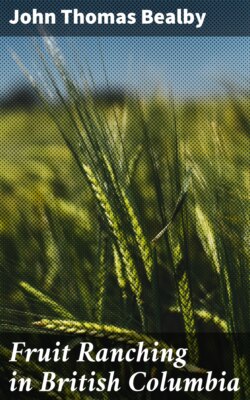Читать книгу Fruit Ranching in British Columbia - John Thomas Bealby - Страница 7
На сайте Литреса книга снята с продажи.
Fruit-growing Capabilities of the Kootenays.
ОглавлениеTable of Contents
Any sensible man who contemplates investing brain, muscle, and capital in British Columbia, whether in mining, lumbering, or fruit-growing, will naturally seek information from the Agent-General of that province in London. And I am sure, from the present distinguished holder of that office, the Hon. J. H. Turner, formerly Prime Minister of British Columbia, any and every inquirer will always receive patient and courteous attention, and be given true, disinterested information, as well as sound advice.
When I myself was discussing with him the subject of fruit-growing in the province which he represents, he said, speaking of the flavour of apples: "In my opinion the finest-flavoured apple is that grown in England, the next in point of flavour is the apple grown on Vancouver Island—but in saying this I may be prejudiced, for forty years of my life have been spent on that island—and after that comes the apple of the interior of British Columbia." A perfectly honest and candid opinion! All the same, it is an opinion which I for my part am not able to indorse. Of the Vancouver Island apple I have no experience whatever. Consequently I leave it entirely out of the account. But with regard to the apples grown in the interior of British Columbia, at any rate in the district of Kootenay, in the south-east corner of that province, I have no hesitation in declaring that there are varieties grown there which, in point of flavour, are every whit the equals of the choicest English apples. The varieties I have in mind are Gravenstein, Wealthy, McIntosh Red, Golden Russet, Grimes' Golden, Ribston Pippin, and Northern Spy. These, as the English fruit-grower will observe, are all Canadian varieties except two—the Golden Russet and the Ribston Pippin. In both these cases I would honestly prefer the British Columbian product. On the other hand, the Blenheim Orange, as grown in British Columbia, seems to me to be, in point of flavour, unquestionably inferior to the English variety.
I have mentioned this little matter to exemplify the strict and careful impartiality which is displayed by Mr. Turner. It shows that he is a man who is conscientiously desirous not to mislead, that he is a man in whom the inquirer may repose full confidence—even as I did myself.
But the prudent inquirer will not rest content with making inquiries in London alone. He will extend his investigations to British Columbia itself. He will seek to acquire information in the actual district in which he contemplates settling. If, however, he prefers to leave the selection of his district open until he has an opportunity to see the country and investigate for himself, then he must, of course, spread the net of his inquiries wider, and seek his information in more than one district of the province.
For my own part, I was pretty well decided, even before I left England, that the district which would suit me best was the vicinity of Nelson, an important little town on the west arm of Lake Kootenay. One advantage accruing from this was that I was able to push my inquiries deeper, and to make them more circumstantial.
Nelson, then, was from the first the end and object of our journey.
Almost the first thing I did, after the idea of settling in British Columbia had taken root in my mind, was to subscribe to two or three of the local newspapers published in the Kootenays, and more especially in the vicinity of Nelson. These sheets are, of course, written, not for the use of readers in England or in any other distant land, but for the entertainment and information of the people dwelling on the spot. Hence the news they convey, the intelligence they impart, and the facts they give are, as a rule, devoid of prejudice: that is to say, they have not been penned for the purpose of throwing dust in the eyes of the stranger or glossing the truth to mislead the unwary. And even if they were so, it is generally possible, with a moderate exercise of the critical faculty, to read between the lines, and so to obtain some fair insight into actual conditions and actual circumstances.
Having read these newspapers for a period of eight or nine months, and having made personal inquiries by means of definite questions, concisely put—inquiries addressed to all sorts and conditions of men—I formed certain conclusions as to the actual state of affairs, as regards fruit-growing, in the Kootenays. These conclusions I will endeavour to summarise.
The industry, viewed as professional fruit-growing, was in its infancy, not more than two or three years old. At the same time, there were just a few orchards containing trees old enough to produce crops which showed what the capabilities of the district were. The fruit which was produced took high rank—exceptionally high rank—not only by virtue of its size, its shape, its colour, its quality, but also by virtue of the consistency and the abundance of its yield. This was demonstrated by the way in which it held its own on the show boards both in America and at the Royal Horticultural Society's exhibitions of Colonial fruit at Westminster and other places in the British Isles. And it was also testified to by the opinions of men whose judgment was not lightly to be set aside—namely, professors of horticulture at U.S. universities and colleges, professors from agricultural and fruit-experimental farms in Eastern Canada—and opinions vouched for by visitors who were more or less practical fruit-growers, if not experts in their several lines of orchard work.
